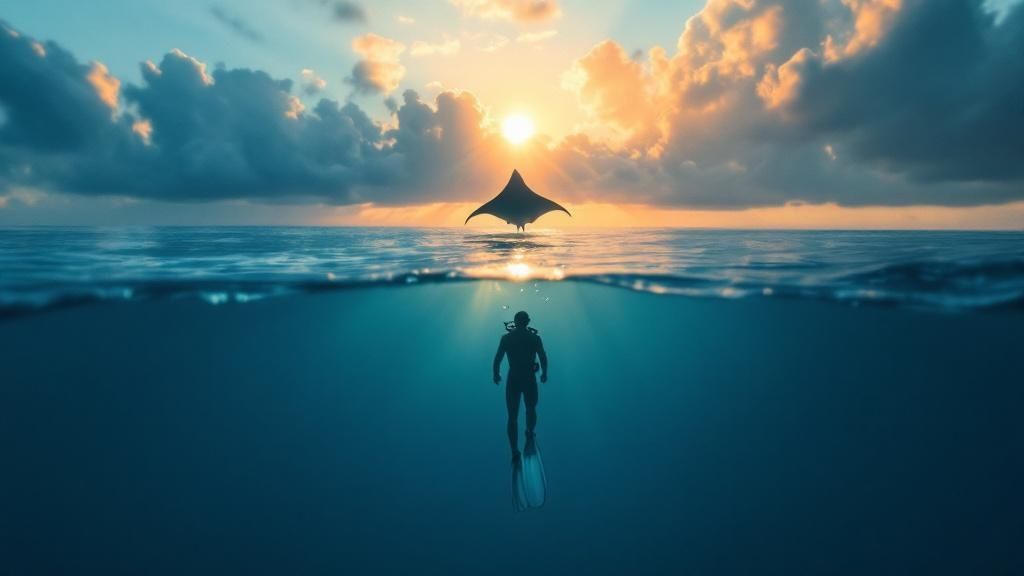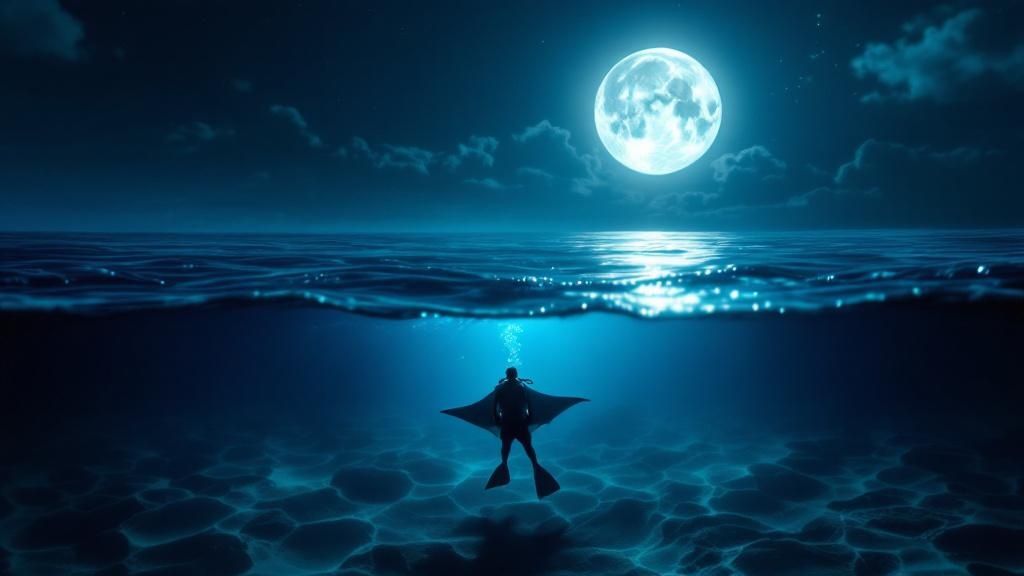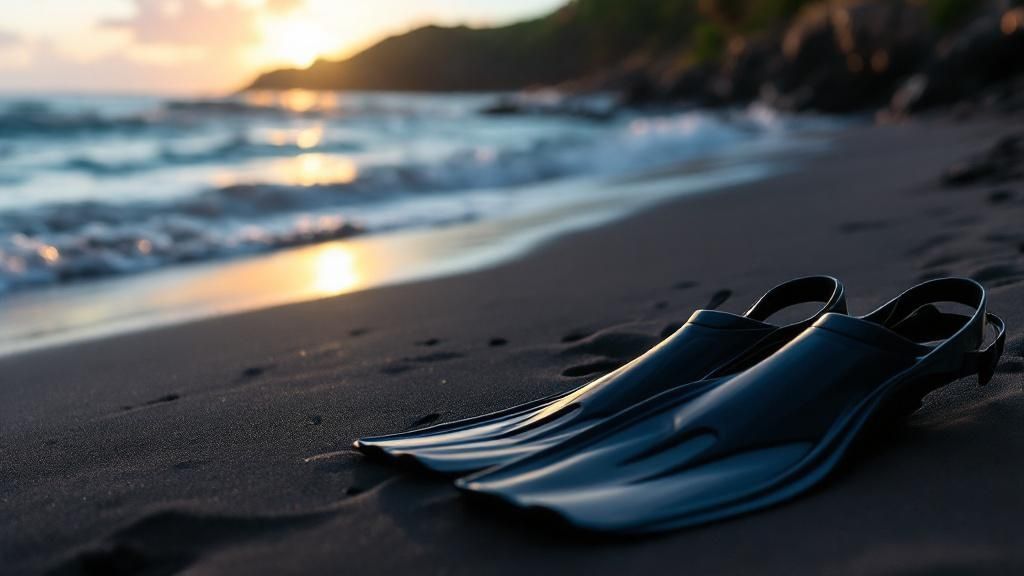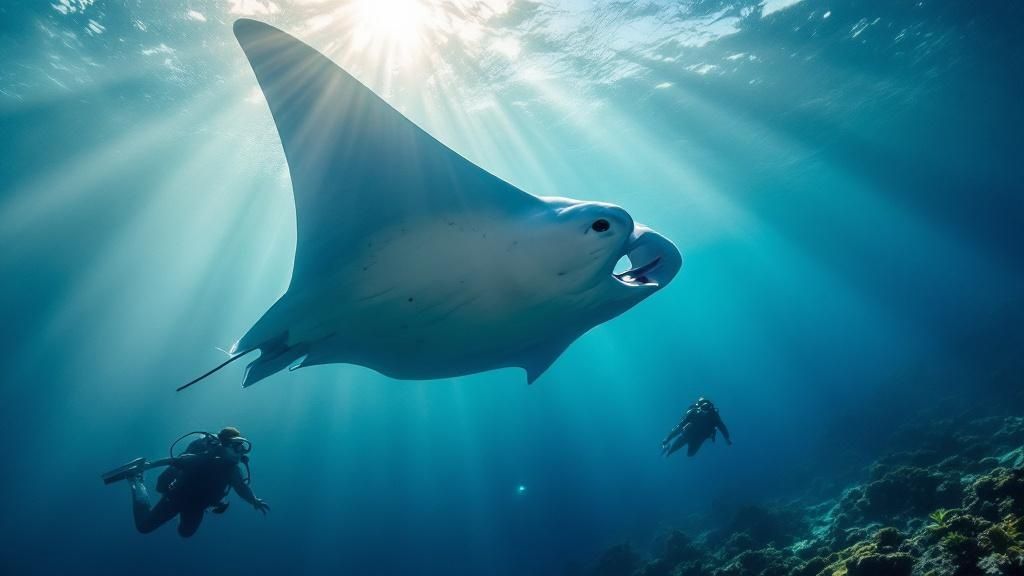Picture this: you’re floating in the warm, dark waters of the Pacific. Suddenly, massive, graceful manta rays glide within inches of you, barrel-rolling through beams of light. This isn’t something you watch on a nature show; this is the Kona manta ray night dive, one of the most reliable and jaw-dropping marine encounters you can have anywhere on the planet. There's a very good reason it's consistently voted one of the best dives in the world.
Welcome to Kona's Underwater Ballet
The Big Island’s Kona coast is world-famous as the place to go for manta ray encounters. It’s an experience where the line between just watching and truly being part of the action completely dissolves, forging a personal connection with these gentle giants. The whole thing feels magical, yet it's surprisingly accessible, drawing thousands of people every year to see the spectacle for themselves.
This guide will walk you through everything you need to know to get ready for this unforgettable adventure. We'll cover what makes the manta ray dive kona so unique, from the simple science behind the nightly gathering to the nuts and bolts of booking your trip. Whether you're a seasoned diver or have never even worn a snorkel mask, you're about to find out why this is a must-do for anyone who loves the ocean.
A World-Famous Marine Encounter
Kona isn't just another spot on the map; it's the global capital of manta ray tourism. The local snorkel and dive tours attract around 80,000 people every single year—a number that speaks volumes about how consistently amazing this experience is. This not only supports our local economy but cements Kona's reputation as the best place on Earth to see these animals. For a closer look at what makes this tour so special, check out our in-depth guide to the manta ray night dive in Kailua-Kona.
If you can, aim for the peak season, from April to October. This is when you'll find the absolute best conditions.
- Warm Water: The ocean is a comfortable 75°F to 80°F.
- High Sighting Rates: Operators regularly see an average of 8 to 12 mantas a night.
- Calm Seas: The weather is typically on your side, making for a smoother boat ride and a more pleasant time in the water.
The real magic here is how predictable it all is. We use powerful, eco-friendly lights to attract plankton, essentially setting up a nightly buffet that the manta rays just can't turn down. It's this unique, symbiotic relationship between the tour operators and the mantas that makes the encounter so reliable and special.
This incredible consistency is what turns a simple dive into a guaranteed spectacle of nature. You can get more context on what makes Kona a world-leading destination by discovering more insights about Kona's manta dive statistics on konahonudivers.com.
Choosing Your Perfect Manta Ray Adventure

Deciding on your Kona manta ray experience is a bit like choosing your seats for a world-class show. Do you want a front-row seat on the ocean floor, or a stunning balcony view from the surface? Your first big choice is between diving and snorkeling, as each one gives you a completely different, yet equally incredible, perspective on this underwater ballet.
If you’re a certified diver, you get to be right in the action. Divers descend to the sandy bottom, usually somewhere between 25 to 35 feet deep, and settle down in a semi-circle. You'll point your dive light straight up, creating a beam that attracts the plankton. Before you know it, the stars of the show—the mantas—arrive to feed, soaring and looping directly over your head. It’s an upward-facing spectacle that feels truly otherworldly.
Snorkelers get the bird's-eye view. You'll float comfortably on the surface, holding onto a custom light board that shines down into the darkness. From this vantage point, you can see the entire scene unfold. You’ll watch multiple mantas gracefully weave between the divers' light beams below. It’s a breathtaking panorama of motion and light.
Kona Manta Dive Site Comparison
Once you've decided how you want to see the show, you need to pick the venue. The two main locations for a manta ray dive in Kona are affectionately known as Manta Village and Manta Heaven. Both are fantastic, but they have distinct personalities that might make one a better fit for you.
Here’s a quick breakdown to help you decide.
| Feature | Manta Village (Keauhou Bay) | Manta Heaven (Garden Eel Cove) |
|---|---|---|
| Success Rate | Extremely reliable; sightings on over 90% of nights | Very consistent, but slightly less than Manta Village |
| Number of Mantas | Consistently good numbers, but often fewer than Manta Heaven | Often sees a higher average number of mantas per night |
| Boat Ride | Very short (5-10 minutes from Keauhou Bay) | Longer (30-45 minutes from Honokohau Harbor) |
| Depth | Slightly shallower and very accessible | Slightly deeper with more varied topography |
| Best For | Divers prone to seasickness, families, or those wanting a near-guaranteed sighting | Divers wanting the chance to see a larger group of mantas and don't mind a longer boat ride |
Honestly, you can't go wrong with either spot. The local operators have perfected the process at both locations, so you're in for an amazing time no matter what. The real question is simply which experience best matches your personal style and comfort level.
Snorkel or Scuba Dive
So, what's the final verdict? It really boils down to your comfort in the water and whether you hold a scuba certification.
Snorkeling is open to just about everyone, from kids to grandparents. There’s no special training needed, and it's a fantastic, low-stress way to witness the magic.
Diving, on the other hand, is more immersive and, frankly, more intense. There is nothing quite like being on the ocean floor as a gentle giant with a 12-foot wingspan glides just inches above your mask. It's a feeling that’s almost impossible to put into words. If you're a certified diver, the manta ray dive kona is an absolute bucket-list essential.
If you're still on the fence, we've got more insights to help you decide. Check out our detailed article on why you should go on a manta ray dive in Kona.
Ultimately, both experiences offer a profound and unforgettable connection with Kona's majestic manta rays.
What to Expect on Your Night Dive Tour

It always helps to know the play-by-play before you go. Having an idea of the flow of your manta tour can help you relax and just soak it all in. From the moment you step on the boat to that warm hot chocolate on the ride home, everything is built around making this an unforgettable night.
Your evening kicks off with a simple check-in at the harbor. Once you're welcomed aboard, the crew will help you get your gear situated and run through a quick but critical boat briefing. They’ll cover the boat's layout, safety gear, and most importantly, the do's and don'ts for safely interacting with the mantas.
As the boat heads out, you're usually treated to an incredible Kona sunset. Watching the sky explode in color over the Pacific is the perfect, peaceful start to the adventure. It’s also a great time to chat with the crew, ask questions, and get settled.
The Underwater Light Show
Once the boat is anchored at the dive site, the real show gets underway. The crew drops what we call the "campfire"—a big, powerful light station—onto the ocean floor. This light does two things: it lights up the whole scene for you, and more importantly, it attracts clouds of plankton, which is exactly what the mantas are here to eat.
As a diver, your job is pretty straightforward. You'll descend with your group to the sandy bottom, which is usually around 25 to 35 feet deep, and find a spot around the campfire.
The feeling is one-of-a-kind. You settle onto the seafloor, aim your dive light straight up, and just wait. There’s this moment of pure anticipation in the dark, knowing these massive creatures are about to appear right over your head.
Snorkelers get an equally amazing, just different, view from the surface. You'll hang onto a specially designed floatation board that has its own bright lights shining down into the water. This creates a column of light that draws the plankton and the mantas right up to the surface for an eye-level encounter.
Graceful Giants Up Close
And then, it happens. A shadow emerges from the darkness, gliding effortlessly into the light. Then another, and another. These gentle giants, with wingspans that can stretch over 12 feet, begin their silent, underwater ballet. They swoop, glide, and do these incredible barrel rolls, their giant mouths wide open to filter the plankton-rich water.
They get so close you can hardly believe it, sometimes passing just inches above a diver's head or just below the snorkel board. Seeing the unique spot patterns on their bellies against the dark ocean is something no photo or video can ever do justice. If you're curious about the science behind it all, you can learn more about what exactly a manta ray night dive is and why it works so well.
After about 45 minutes of pure awe in the water, it's time to head back to the boat. Most crews greet you with hot chocolate and snacks, which is the perfect way to warm up and buzz about what you all just saw. The quiet ride back to the harbor under the stars is a beautiful way to cap off a truly epic night.
How to Interact with Mantas Safely and Responsibly

The incredible success of the manta ray dive in Kona all comes down to a simple, yet profoundly important, idea: responsible tourism. We are just visitors in the mantas' world, and their safety and well-being have to be the top priority for every single dive operator. We achieve this through a model of passive interaction.
Think of it like being in a world-class art museum. The rule is simple: look, but don't touch. These manta rays are the masterpieces, and our job is to observe them without getting in the way. It’s the only way to ensure this amazing encounter is around for future generations to experience.
The most critical rule of all is to never, ever touch a manta ray. Their skin is covered in a thin, protective layer of mucus. This slime coat is their immune system, their first line of defense against bacteria and infections. Touching them, even with the lightest finger, can strip this layer off and leave them vulnerable to disease.
The Rules of Engagement
To keep the experience safe and enjoyable for both people and mantas, all the local operators stick to a strict set of guidelines. These rules are all about preventing stress on the animals, allowing them to feed naturally and completely undisturbed. When you follow them, you're playing a direct part in conservation.
Your position in the water is everything:
- For Divers: You’ll be instructed to stay right on or very near the sandy bottom. This creates a wide-open water column above you, giving the mantas all the space they need to swoop and feed without running into you. You are essentially the floor of their dining room.
- For Snorkelers: You'll stay flat on the surface, usually holding onto a custom-built light board. This gives you a phenomenal bird's-eye view while keeping you clear of the mantas' flight path. Whatever you do, don't dive down toward them.
Letting the mantas control the entire encounter is the key. No chasing, no grabbing, and definitely no trying to ride a manta ray. You just have to stay still and let them come to you—which they often do, sometimes gliding just inches over your head. To learn more about what makes these interactions so special, you can read our guide on what you should know about the manta ray dive in Kona.
Light and Bubble Etiquette
Even your flashlight and your breath can make a difference. Divers are asked to shine their lights straight up toward the surface, while the snorkelers' lights shine down from above. This creates a "light sandwich" that concentrates the plankton in one spot, making it an easy buffet for the mantas.
A core tenet of a responsible manta ray dive is allowing the animals to approach on their own terms. When you remain still and passive, their curiosity often takes over, leading to breathtakingly close and natural encounters.
Finally, as a diver, try to avoid blowing your exhaust bubbles directly into a manta's face as it glides overhead. It's a simple courtesy. These small acts of respect are what keep the Kona manta population healthy and willing to share their incredible nightly ballet with us.
The Science Behind Kona's Manta Phenomenon

The incredible consistency of the manta ray dive kona isn't some kind of island magic. It’s actually a brilliant (and beautiful) case of simple biology, predictable behavior, and a little bit of human help. The whole spectacle hinges on a basic food chain reaction that starts with plankton, the tiny organisms that are the foundation of ocean life.
These microscopic critters are instinctively drawn to light—a behavior called phototaxis. When dive boats switch on their powerful underwater lights, it's like ringing a massive dinner bell. Swarms of plankton gather in the bright beams, creating a thick, soupy buffet that the local manta rays have learned they can count on. It's a guaranteed meal, and they know it.
This reliable nightly feast is precisely why the mantas return to the same spots, night after night. They've figured out that these specific locations offer an easy, energy-efficient meal.
A Living Underwater Laboratory
What really takes this from just a cool dive to a truly special encounter is the ongoing research right here in Kona. We don't just watch the mantas; we get to know them. Every manta ray has a unique pattern of black spots on its belly, which works just like a human fingerprint. Local researchers and seasoned dive guides can actually identify individual mantas by these spot patterns.
This has blossomed into an amazing community-wide science project where mantas are given names and their life histories are carefully tracked. So on your dive, you might hear your guide say, "Look, that's Lefty! We've been diving with him for over 20 years."
This personal connection completely changes the experience. You're not just seeing a manta ray; you're meeting a named individual with a known history. It makes the encounter incredibly personal and far more meaningful.
Tracking Kona's Resident Mantas
The local community is serious about data collection. For instance, between 2009 and 2014, underwater videographers meticulously documented the nightly gatherings at Manta Village and Manta Heaven. They recorded which mantas showed up, their condition, and how they behaved, building a rich database that helps us understand their movements and social lives. You can even discover more about these manta ray findings and their impact on local research.
This kind of long-term observation makes a manta ray dive kona more than just an adventure—it’s a direct contribution to conservation. The information gathered helps us protect these gentle giants. A huge part of that effort is choosing a dive operator who respects the animals and the research. Our guide on how to choose a Kona dive shop can point you toward teams that are truly committed to manta conservation.
Frequently Asked Questions About the Manta Ray Dive
Thinking about taking the plunge on a manta ray dive in Kona for the first time? It's totally normal to have a few questions buzzing around. From safety to logistics, getting your questions answered ahead of time is the best way to make sure you can just relax and soak in every moment of this once-in-a-lifetime adventure.
We've heard just about every question there is from first-time divers and snorkelers. Here are the most common ones, with straightforward answers to help you feel confident and ready to go.
Is It Safe to Swim with Manta Rays?
Yes, absolutely! This is hands-down one of the safest and most gentle large animal encounters you can have in the ocean. Manta rays might be huge, but they are completely harmless to people.
Here’s why you can breathe easy:
- No Stingers: Unlike their stingray cousins, manta rays have no barb or stinger on their tail. They have no way to hurt you.
- Filter Feeders: They only eat tiny plankton. Mantas are not predators and have zero interest in people as a food source.
- Gentle Nature: These animals are famous for their curious but peaceful temperament. They’re just gliding by for dinner, and any interest they show in us is pure curiosity.
Honestly, the only real "danger" on this dive is accidentally touching the reef or a sea urchin, and your guides will be right there to help you steer clear.
The whole experience is built around passive observation. The mantas are in charge. Our job is simply to be respectful guests, watching their nightly feeding ballet unfold.
What Happens If No Mantas Show Up?
The Kona manta ray dive has a sky-high success rate—we're talking over 90%—but at the end of the day, these are still wild animals. On very rare nights, they might decide to dine elsewhere.
When this happens, any reputable tour operator will have a "manta guarantee." This almost always means you get to rebook your tour for another night, completely free of charge. It’s a standard, good-faith practice in the local industry.
To be on the safe side, always ask about an operator's specific policy before you book. We always tell people to schedule their manta dive for one of their first nights in Kona. That way, if you do need to reschedule, you have plenty of flexibility without messing up your other vacation plans.
Do Manta Rays Have a Season in Kona?
This is one of the best parts about the Kona experience: there is no "off-season." Our local manta population is made up of residents, which means they live here all year long and don't migrate.
They show up for their plankton buffet almost every single night, no matter the month. Sure, the ocean might be a bit calmer and warmer in the summer, but your chances of an incredible encounter are fantastic any time of year.
This year-round reliability is a huge reason the manta ray dive kona has become world-famous. It's a cornerstone of our local economy, generating over $2.5 million in annual revenue and supporting countless local businesses. You can dive deeper into the science and economics of it by reading the full research on manta ray tourism in Hawaii on hamerinhawaii.org.
What Is the Difference Between Diving and Snorkeling?
The biggest difference is your perspective. Think of it like seeing a concert: you can have a front-row seat on the floor, or you can have a fantastic view from the balcony. Both are amazing, just different.
-
Diving: If you're a certified diver, you'll descend about 30 feet to the sandy ocean floor. You'll kneel or sit and look up as the mantas swoop and barrel-roll right over your head. It’s an incredibly immersive feeling.
-
Snorkeling: As a snorkeler, you'll float comfortably on the surface, holding onto a custom light board that attracts the plankton. You'll look down on the whole scene, watching the mantas weave through the divers' lights below.
Both give you a spectacular show. Snorkeling is great because almost anyone can do it, no certification needed. Diving offers that up-close, personal feeling that many divers consider an absolute bucket-list experience.
Ready to meet these gentle giants yourself? Kona Honu Divers offers world-class manta ray night dive and snorkel tours led by experienced professionals who prioritize safety and sustainability. Book your unforgettable underwater adventure with us today at https://konahonudivers.com.
